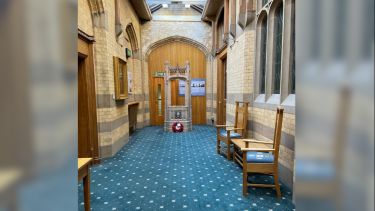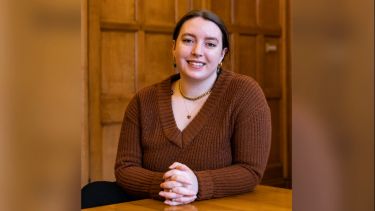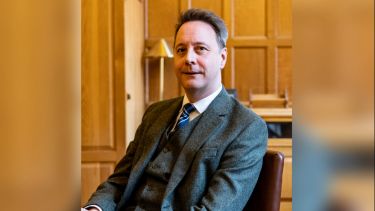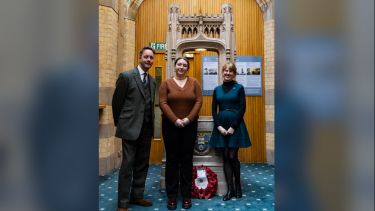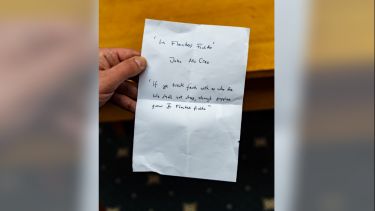Once you take the stairs to the first floor of Firth Court and turn to your left towards the Chancellor’s Room, at the end of the corridor you will find a 10-feet-tall war memorial, resting on the turquoise carpet that’s spread beneath it.
By looking through the opening carved out inside the Gothic structure made of grey Hopton Wood stone, you will meet four pairs of eyes belonging to our graduates and students, whose brave spirits were forever captured in black and white portraits.
Lydia Manley Stewart Henry, Major William Barnsley Allen, William Harold Armitage, and Alphaeus Abbot Casey; despite their differing fates, where some lived through decades and others fell in the midst of battle, they have all witnessed the horrors of war, whether it was inside the hospitals or the trenches.
On your left, the words ‘To them the glory. To us the freedom’ are spread across another panel, summarising the formation of the Sheffield Pals Battalion and the thousand men, including our staff and students, who filled its ranks. The Sheffield Pals Battalion was started by two students and the University Vice-Chancellor, Herbert Fisher, to boost the recruitment numbers by assuring those enlisted that they would face the fight alongside friends and neighbours.
Unfortunately, 512 men sadly lost their lives during the battle of the Somme but are remembered in the enclosed Book of Remembrance.
While the war memorial is a constant reminder of the tragedies that occurred, the two information panels act as a magnifying glass into the lives and deaths of Sheffield people who took part in the four-year-long war, and whose names and faces will remain engraved in the University’s history.
You can download the two information panels to take a closer look at their contents:
The people behind the project
It took Holly Cooke, an American History masters graduate, 200 hours to research, write up and complete the project during her 100-hour degree placement and 100-hour paid summer internship that both took place last year.
Holly said: “There were a lot of things that I just didn’t know about Sheffield in general, and there are a lot of things that are included in the panels that I got to learn about as well.”
Referring to Lydia Manley Stewart Henry, who was one of the first to be enrolled in our Medical School and a daughter of one of the University’s first female lecturers, Holly added: “In my eyes, it seemed both so early yet so late in history for women to graduate from the University, but they paved the way for other women to follow in their footsteps.
“It’s important not to forget the innocent citizens who were affected by the war and for them not to become part of lost histories. As someone who is specialising in American history and was given the opportunity to research British history on a local level, suddenly finding all this accessible information in the archives was fascinating. Taking Lydia’s story as an example, I haven’t realised that a lot of it was already accessible and scattered across the Internet, but it was a fulfilling experience for me to be responsible for compiling it all together in one place.
“Even when the first drafts were just finalised, it already felt amazing. After spending so much time researching all the archives to turn them into information panels, it’s very rewarding to be able to look at the final product in person and think that I played a part in helping it all come to life.”
The project as a whole was organised and overseen by Emily Green, University Heritage Collections Manager, whose aim is to make the University’s cultural heritage accessible to the wider community since starting her role three years ago.
Emily said: “People constantly walk past the war memorial, which was originally unveiled as part of the University’s 21st anniversary in 1926 in the Edgar Allen Library, which is now the Rotunda, before being moved to its current location in the 1960s after the opening of Western Bank Library.
“I wanted the significance of the war memorial to be highlighted and for people to understand why we have it and what it represents. Being the Heritage Collections Manager, my work is dedicated to delivering projects that would make people stop, notice and appreciate the art, sculptures, and the overall architectural fabric of the University; for them to understand why it’s all here and what it all represents.
“We have staff and students who spend a lot of time on campus and they have probably never seen the war memorial. The information panels and the memorial are also located in a high profile area, and we constantly have events and international visitors come through. Giving them some hints about why Sheffield is important through the stories of its people just makes it all more poignant and interesting for our global community.”
Speaking of how the project has supported Holly’s academic and professional development, Emily added: “It was important to provide Holly and other students undertaking similar projects with an essential skill set for them to be able to interpret history and make it more publicly accessible.”
This project was also able to come to fruition thanks to a generous donation from Miles Stevenson, who established the Development and Alumni Relations Office at the University in 2002, which is now known as Campaigns and Alumni Relations. Over the 18 years that he spent here, he played a key role in growing the team, building the alumni relations programme, and raising philanthropic funds across the organisation.
Miles said: “I knew Emily wanted to do this project, but I didn't know that she had a fantastic idea of getting a student to actually drive it forward.
“I was a self-funded postgraduate when I was at university, so being part of a project like that as a student enables you to apply your skills of what you've been learning to something that is tangible and visible.”
Taking out a piece of paper from inside his jacket, Miles reads out the famous words of the In Flanders Fields poem, written by John McCrae.
Miles said: “It has this line in it - If ye break faith with us who die, we shall not sleep, though poppies grow, in Flanders fields - all those people who ended up paying the ultimate sacrifice, we should never forget them."
Miles, who himself had studied history for his bachelors and masters degrees, added: “Creating some way for people to remember and understand the tragedy in an appropriate manner without glorifying the war is incredibly important.”

